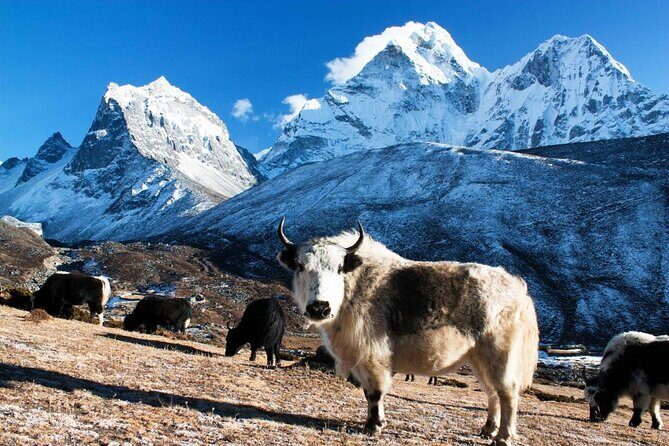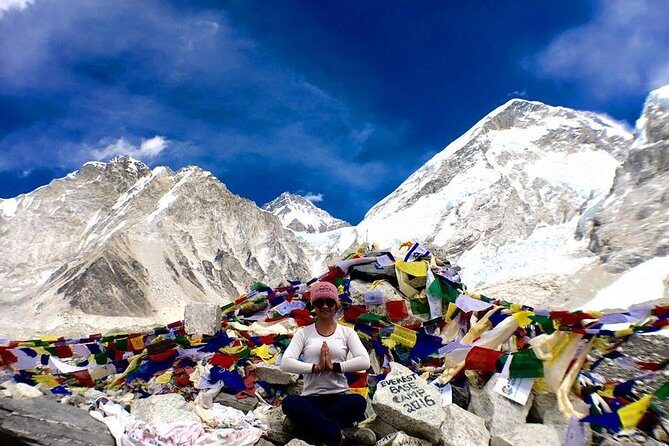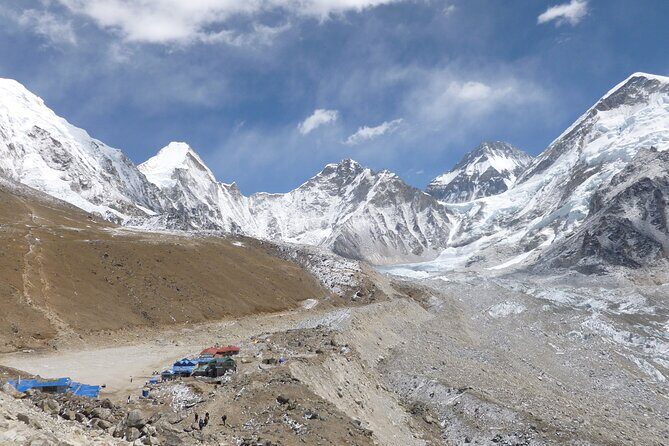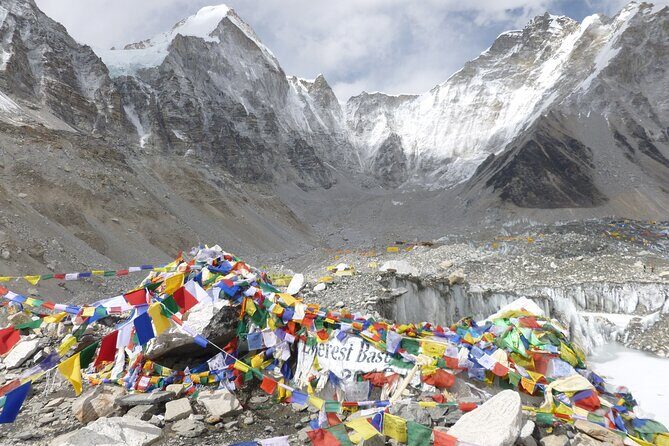Tackling Everest Base Camp isn’t just about bagging a world-famous mountain; it’s about walking through some of the most awe-inspiring scenery on the planet, with a knowledgeable guide by your side. For $1,350 per person, this 14-day guided trek offers a well-rounded balance of adventure, culture, and comfort, especially suited for active travelers with moderate fitness. From Kathmandu’s bustling streets to the quiet serenity of the Khumbu Valley, you’ll experience breathtaking mountain views, Sherpa hospitality, and a journey that stays with you long after you return home.
Two aspects we particularly love about this trek are the small group size—a maximum of 10 people—ensuring personalized attention, and the inclusive logistics, which cover accommodations, meals, and local transport, letting you focus on the journey rather than the planning. The flight from Kathmandu to Lukla early in the trek offers a spectacular panoramic view of snow-capped peaks, a highlight in itself, and the trek’s carefully designed itinerary makes acclimatization manageable.
One thing to consider is that this tour requires a good level of physical fitness. The terrain is challenging, especially at higher altitudes, and the ascent to Kala Patthar or Everest Base Camp involves steep sections. So, if you’re not used to hiking or altitude, it’s worth preparing thoroughly.
This trek is perfect for those who want an authentic experience with expert guides, enjoy stunning mountain vistas, and are comfortable with moderate physical activity. It’s especially praised by travelers and highly recommended for anyone eager to see Everest and its surrounding giants without the hassle of logistical planning.
Key Points

- All-inclusive experience: Lodging, meals, transportation, and guides are included, simplifying logistics.
- Small-group format: Max. 10 travelers for personalized support.
- Authentic cultural encounters: Learn about Sherpa culture, visit monasteries, and explore local villages.
- Stunning views: Pass through pine forests, cross high-altitude passes, and get panoramic mountain vistas.
- Strong emphasis on safety and acclimatization: Well-planned stops help reduce altitude sickness risks.
- Expert guides: Knowledgeable guides enhance understanding and safety on the trail.
The Journey Begins in Kathmandu

Starting in Kathmandu, the trek offers a taste of Nepal’s vibrant culture and chaotic charm. Your team meets you at Tribhuvan International Airport, and after a private transfer to your hotel, you can enjoy a meal or rest before the adventure begins. The next day’s highlight is the flight to Lukla—renowned for its spectacular sunrise views on the snow-covered mountains. This short 40-minute flight sets the tone for what’s to come and is often praised in reviews. Many travelers mention how stunning and memorable the flight is, with one reviewer noting, “The flight to Lukla gives outstanding views of the early morning sunrise on the snowcapped mountains.”
Love the outdoors? Here are other hiking experiences we've covered in Kathmandu
First Steps on the Trail: Phakding and Namche Bazaar
Descending from Lukla, the trek starts with a walk through lush pine forests and along the Dudh Koshi River. You’ll rest in Phakding, which is a gentle introduction to Himalayan trekking. The next day involves a steep ascent to Namche Bazaar, the bustling hub of the region. The climb rewards trekkers with a spectacular first view of Everest, as well as ridges of Lhotse and Nuptse. One reviewer called it “the first sight of marvelous Mount Everest,” highlighting how the scenery impresses even on the first full day. Namche is also where you’ll find cafes, ATMs, and shops—more than enough amenities for the region.
Acclimatization and Local Culture
Namche’s day of rest (or light exploration) is crucial for adjusting to altitude. Travelers often mention how well the guides organize these acclimatization hikes, with one reviewer stating, “We went for a short hike to a nearby viewpoint and explored the town, which helped prevent altitude issues.” Visitors also get to learn about Sherpa culture at the Tourist Visitor Center, making this stop both scenic and educational.
The High-Altitude Challenge: Phorse, Dingboche, and Beyond
From Namche, the trail takes you through enchanting rhododendron and pine forests, passing through villages like Phorse, where views of Ama Dablam and Thamserku become familiar sights. Trekkers often mention how the route “passes through villages of Shomare, Orsho, and Tsuro Wog,” with each offering stunning mountain vistas. Dingboche, a large village, is a good acclimatization stop—many travelers appreciate the chance to explore its monasteries and learn about local traditions. One review notes, “The trek through alpine forests and villages was full of breathtaking mountain views like Mount Nuptse and Mount Lhotse.”
Approaching Everest: The Critical Climb to Kala Patthar
As you ascend toward Everest Base Camp, the scenery intensifies—glacial terrains, rugged moraines, and prayer flags adorn the path. The hike to Kala Patthar is a highlight—offering one of the best panoramic views of Everest and the surrounding peaks, even if Everest itself isn’t visible from here. Many reviewers describe their experience: “Climbing Kala Patthar, with its spectacular views, was unforgettable.” The early morning start is recommended, and the ascent can be demanding. Expect a steep climb and some altitude symptoms but know that your guides aim to manage this safely.
Everest Base Camp and Gokyo: The Pinnacle
Reaching Everest Base Camp is a milestone—an authentic feeling of standing at the foot of the world’s tallest mountain. While the Base Camp itself is a busy, rugged site, the journey there is what sticks with most travelers. The trek then continues to Gokyo, offering vistas of glaciers and lakes.
The Return and Reflection
Descending back from the high altitudes, the trail leads through familiar villages and forests, with many noting the emotional relief of reaching Lukla again. The flight back to Kathmandu is another scenic highlight, and many reviews praise the smooth logistics arranged by the operator.
Why This Trek Stands Out
Based on reviews, the guides—like Gopal, Nishan, and Bishwa—are often singled out for their knowledge, friendliness, and professionalism. Having a guide who understands the terrain and local culture transforms the trek from a simple hike into a meaningful experience. Reviewers also highlight the quality of the accommodations—many nights spent in cozy teahouses with hearty meals—that make the high-altitude journey more comfortable.
The stunning mountain views are genuinely breathtaking, with many travelers describing their moments at Kala Patthar or Thangma Riju as among the most memorable sights in their lives. The included flight to Lukla, the scenic trail, and the cultural stops all add to the value, making the $1,350 price point quite reasonable for such an adventure.
A Few Considerations
While the trek is well-organized, it’s essential to know that altitude sickness can be a concern. The itinerary includes acclimatization days, but travelers still need to be prepared physically and listen to their bodies. Also, the terrain can be challenging—steep ascents, rocky paths, and high-altitude stretches mean this trip is best suited for active, reasonably fit travelers.
Who Should Consider This Trek?

This experience is ideal for adventurous souls who want to witness Everest with a guide, rather than on their own. It’s perfect for those who value small-group camaraderie and want to learn more about Sherpa culture along the way. If you’re looking for a comprehensive, well-organized trek that combines natural beauty, cultural insight, and safety, this trip offers excellent value.
The Sum Up

This Everest Base Camp trek balances stunning scenery, cultural encounters, and logistical ease. The small-group format and expert guides ensure you won’t feel lost or overwhelmed. The included flights, accommodations, and meals make the journey smoother, allowing you to focus on the awe-inspiring views and the thrill of reaching the foot of Everest.
If you’re a moderately fit traveler eager for a once-in-a-lifetime adventure, this trek offers genuine Himalayan magic. It’s particularly suited for those who appreciate authentic local culture and want to avoid the hassle of planning every detail themselves. Many travelers come back saying it’s a trip of a lifetime, and after reading reviews, it’s clear this company consistently delivers a safe, enjoyable, and memorable experience.
FAQ

How long is the trek?
The trek lasts approximately 14 days, from Kathmandu to Everest Base Camp and back, with some days dedicated to acclimatization and rest.
What’s included in the price?
The package includes pickup, accommodations in tea houses, meals, local transportation, and guided support. Flights to and from Lukla are part of the itinerary.
Is this trek suitable for beginners?
It’s best suited for active, moderately fit travelers. The terrain is challenging, and altitude can be demanding, but the itinerary’s acclimatization days help mitigate risks.
How many people are in each group?
Groups are limited to a maximum of 10 travelers, ensuring personalized attention and a more intimate experience.
What are the main highlights?
Expect incredible mountain views, visits to Namche Bazaar, a hike to Kala Patthar for panoramic Everest vistas, and a culture in Sherpa villages and monasteries.
What is the main challenge?
The high altitude and steep ascents can be tough. Proper fitness and pacing are essential, and guides are experienced in altitude management.
Are meals and accommodations comfortable?
Most nights are spent in comfortable teahouses with warm rooms and hearty local food. While basic, reviews highlight the good quality and cleanliness.
Can I customize the itinerary?
The described itinerary is standard, but some operators might offer options like helicopter return or additional side trips; check with your tour provider.
What should I pack?
Layered clothing, sturdy hiking boots, a warm jacket, gloves, and a hat are essentials. Some reviews mention the importance of proper gear for comfort and safety.
How do I get to Kathmandu after the trek?
You’ll fly back from Lukla to Kathmandu, after which you can enjoy sightseeing, shopping, or relaxing before your departure.
Embarking on the Everest Base Camp trek is a bold choice, but with the right guide and preparation, it becomes a life-changing experience. Prepare to be moved by the mountain’s grandeur and the warmth of the Sherpa people, and you’ll cherish this adventure long after you’ve left the Himalayas behind.
More Hiking & Trekking Tours in Kathmandu
More Tour Reviews in Kathmandu
More Kathmandu experiences we've covered
- Rolwaling Himal Trek 8 Days
- Nepal: 7-Day Adventure Tour: Kathmandu, Pokhara & Chitwan
- From Kathmandu: Bungee Jump over Bhotekosi River
- Kathmandu City in One Day with Bodhnath Stupa
- Kathmandu Full Day City Tour
- Kathmandu City Tour by private Car.
- Trishuli River Rafting Kathmandu 1 day
- From Kathmandu: Upper Mustang Jeep Tour
- From Kathmandu: 2 Day Short Wildlife National Park Tour
- All Nepal Tour
- Everest base camp Helicopter Tour
- Trekkers & Hikers Spa Package by Heritage Spa
